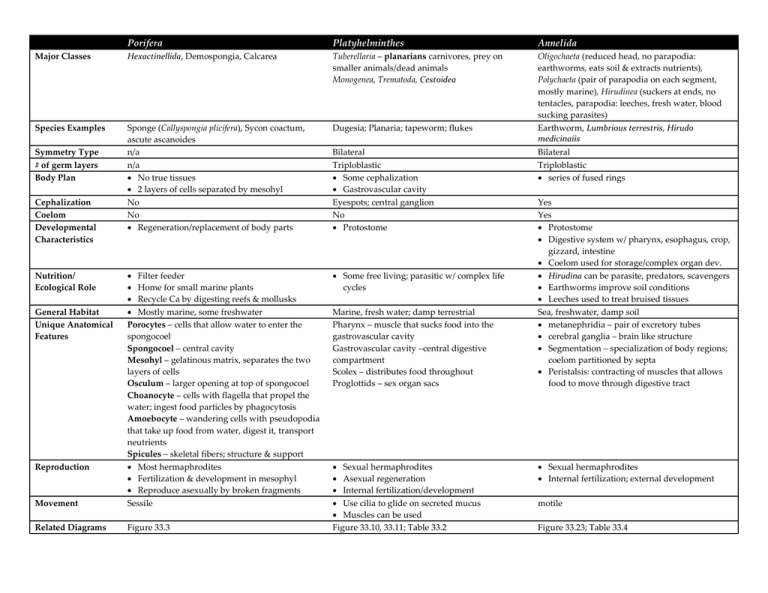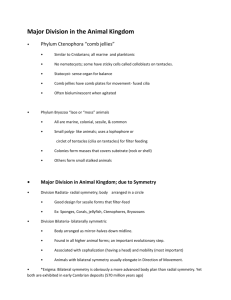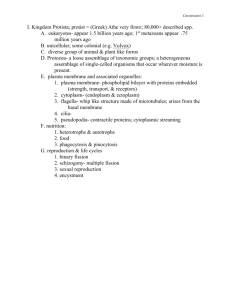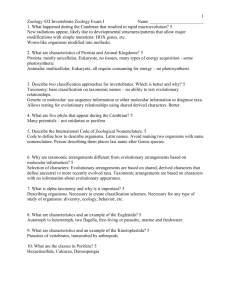Enhanced Invetebrates chart
advertisement

Porifera Platyhelminthes Annelida Major Classes Hexactinellida, Demospongia, Calcarea Tuberellaria – planarians carnivores, prey on smaller animals/dead animals Monogenea, Trematoda, Cestoidea Species Examples Sponge (Callyspongia plicifera), Sycon coactum, ascute ascanoides n/a n/a No true tissues 2 layers of cells separated by mesohyl No No Regeneration/replacement of body parts Dugesia; Planaria; tapeworm; flukes Oligochaeta (reduced head, no parapodia: earthworms, eats soil & extracts nutrients), Polychaeta (pair of parapodia on each segment, mostly marine), Hirudinea (suckers at ends, no tentacles, parapodia: leeches, fresh water, blood sucking parasites) Earthworm, Lumbrious terrestris, Hirudo medicinaiis Some free living; parasitic w/ complex life cycles Movement Filter feeder Home for small marine plants Recycle Ca by digesting reefs & mollusks Mostly marine, some freshwater Porocytes – cells that allow water to enter the spongocoel Spongocoel – central cavity Mesohyl – gelatinous matrix, separates the two layers of cells Osculum – larger opening at top of spongocoel Choanocyte – cells with flagella that propel the water; ingest food particles by phagocytosis Amoebocyte – wandering cells with pseudopodia that take up food from water, digest it, transport neutrients Spicules – skeletal fibers; structure & support Most hermaphrodites Fertilization & development in mesophyl Reproduce asexually by broken fragments Sessile Related Diagrams Figure 33.3 Symmetry Type # of germ layers Body Plan Cephalization Coelom Developmental Characteristics Nutrition/ Ecological Role General Habitat Unique Anatomical Features Reproduction Bilateral Triploblastic Some cephalization Gastrovascular cavity Eyespots; central ganglion No Protostome Marine, fresh water; damp terrestrial Pharynx – muscle that sucks food into the gastrovascular cavity Gastrovascular cavity –central digestive compartment Scolex – distributes food throughout Proglottids – sex organ sacs Sexual hermaphrodites Asexual regeneration Internal fertilization/development Use cilia to glide on secreted mucus Muscles can be used Figure 33.10, 33.11; Table 33.2 Bilateral Triploblastic series of fused rings Yes Yes Protostome Digestive system w/ pharynx, esophagus, crop, gizzard, intestine Coelom used for storage/complex organ dev. Hirudina can be parasite, predators, scavengers Earthworms improve soil conditions Leeches used to treat bruised tissues Sea, freshwater, damp soil metanephridia – pair of excretory tubes cerebral ganglia – brain like structure Segmentation – specialization of body regions; coelom partitioned by septa Peristalsis: contracting of muscles that allows food to move through digestive tract Sexual hermaphrodites Internal fertilization; external development motile Figure 33.23; Table 33.4 Major Classes Species Examples Mollusca Echinodermata Polyplacophora, Gastropoda –spiral shell, torsion( visceral mass rotates up 180°, anus & mantle cavity above head) Bivalvia –shell w/ 2 halves, reduced head, paired gills, filter feeder, cephalopoda –head surrounded by tentacles, speedy, closed circulatory sys., complex nervous sys, brain, sensory organs Snails, slugs, oysters, clams, octopuses, squid Tridacna maxima, Helix aspersa, Enteroctopus dotleini Asteroidea, Ophiuroidea, Echinoidea, Crinoidea, Holothuroidea Symmetry Type Bilateral # of germ layers Body Plan Triploblastic See unique anatomical features Cephalization Coelom Developmental Characteristics Nutrition/ Ecological Role General Habitat Unique Anatomical Features Yes, in some classes Yes Trochophore – ciliated larva stage Mostly soft bodied w/ hard shell Cephalopoda are carnivores Reproduction Sexual Fertilize: water/female’s mantle cavity Develop: water/seafloor Muscular foot, cephalopoda use jet propulsion (water drawn by mantle cavity) Figure 33.16, 33.18, 33.21; Table 33.3 Movement Related Diagrams Marine; some fresh water; some land Muscular foot – movement & stability Visceral mass – contains int. organs Mantle – fold of tissue over visceral mass; secretes shell Mantle Cavity – houses gills, filled w/ water Radula – near mouth; used to scrape up food Sea star, sea urchin, sea cucumber, sea lily Oritireaster linckii, caulerpa racemosa, echincthrix calamaris Bilateral (adult radial appearance is 2nd adaptation to sessile lifestyle) Triploblastic Thin skin covers endoskeleton Water vascular system No Yes Deuterostome Metamorphosis from bilateral larvae Some carnivores, Marine Water vascular system hydraulic canals branch into tube feet; used for movement, feeding, gas exchange pedicellaria – keeps debris off boyd surface, protects skin gills skin gills dermal papillae open circulatory system Sexual External fertilization/development Asexual Regeneration Some are sessile Figure 33.38 Nematoda Caenorhabitis elegans; hookworms, pinworms Trichinella spiralis Bilateral Triploblastic Cuticle covering epidermal cells Longitudinal muscle cells Yes Pseudocoelom Protostome Decomposers, nutrient cycling, parasite, grow/reproduce in humans Aquatic, wet soil, moist tissues of plants Fine tip at posterior end; blunt tip at head Sexual internal fertilization; external development longitudinal muscles = whip like motion Major Classes Species Examples Symmetry Type # of germ layers Body Plan Cephalization Coelom Developmental Characteristics Nutrition/ Ecological Role General Habitat Unique Anatomical Features Arthropoda Cnidaria Aracnida (6 pairs of appendages, chelicerae, pedipalps,walking legs, usesilk) Crustacea (19 appendage pairs, 2 antennae pairs) Insecta (flies, tracheal system, incomplete metamorphasis), Chilopoda (pair of antannea, 3 pairs of mouth parts, poison claws), Diplopoda (many legs) Apis mellifica, Aculepeira cerapegia, Trigoniulus corallinus Bilateral Triploblastic segmentation, hard exoskeleton, jointed appendages completely covered by cuticle (exoskeleton) Yes Yes molting – sheds old exoskeleton to grow a new one; vulnerable during this time metamorphosis – complete change of form (insects, ex. Caterpillar → butterfly) incomplete metamorphosis – young resemble adults (ex. Grasshopper) Some parasites, some carnivores, some decomposers Centipedes – carnivores Mainly land, some water, under your couch Proglottids – flattened segments, important for repro. Mandibles – jawlike structure Sensory antennae Compound eyes – many eyes w/ separate focuses Book lungs (spiders) – stacks of plates for gas exchange Malpighian tubules – removes metabolic wastes in insects Tracheal system – gas exchange in insects Hydrozoa – alternate polyp/medusa form; alternate (a)sexual w/ budding Scyphozoa – medusa primary; live as jellies Anthozoa – only polyps; each polyp built on remains of previous Reproduction Asexual & sexual (usually sexual) Internal fertilization; external development Movement Related Diagrams Legs, wings, Figure 33.26, 33.30, 33.33; Table 33.5 Related source: www.geocities.com/mrsfranksbiology/invertanimalanswers.doc Anemone; jellyfish; coral; hydra Radial Diploblastic Have true tissues Gastrovascular cavity No No Polyp or medusa Carnivore; uses cnidcytes to capture prey & for defense Mostly marine Polyps – cylindrical form, adheres to substratum; tentacles that capture/push prey into mouth --Or— Medusa – upside down motile polyp Gastrovascular cavity –central digestive compartment Nematocysts: cnidocytes that sting & release venom Sac with gastrovascular cavity Epidermis – outer cell layer; provides protection Gastrodermis – inner cell layer; used for digestion Cnidocytes – cells on tentacles used for defense & prey Mesoglea – jelly substance that makes up body; structural support Nematocytes – stinging capsule organelle Nerve net – simple nervous system; enables organisms to respond to physical contact Sexual hermaphrodites External fertilization/development Asexual budding Polyps = sessile; medusa = motile Figure 33.4, 33.5; Table 33.1 Related Diagrams/Tables Phylum Porifera 33-03-SpongeAnatomy-L 33-05-HydraCnidocyte-L Phylum Cnidaria Table 33-1. Classes of Phylum Cnidaria Class and Examples Hydrozoa (Portuguese man-of-war, hydras, Obelia , some corals) (see FIGURES 33.6a and 33.7) Scyphozoa (jellies, sea wasp, sea nettle) (see FIGURE 33.6b) Anthozoa (sea anemones, most corals, sea fans) (see FIGURE 33.6c and d) 33-04-CnidarianForms-L Main Characteristics Most marine, a few freshwater; both polyp and medusa stages in; most species; polyp stage often colonial All marine; polyp stage reduced; freeswimming; medusas up to 2 m in diameter All marine; medusa stage completely absent; sessile, many colonial Phylum Plathelminthes Table 33-2. Classes of Phylum Platyhelminthes Class and Examples Turbellaria (mostly free-living flatworms; e.g., Dugesia ) (see FIGURE 33.9 and 33.10) Monogenea (monogeneans) Trematoda (trematodes, also called flukes) (see FIGURE 33.11) Cestoidea (tapeworms) (see FIGURE 33.12) 33-10-PlanarianAnatomy-L Main Characteristics Most marine, some freshwater, a few terrestrial, predators and scavengers; body surface ciliated Marine and freshwater parasites; most infect external surfaces of fishes; life history simple; a ciliated larva starts an infection on a host Parasites, almost always of vertebrates; two suckers attach to host; most life histories include intermediate hosts Parasites of vertebrates; scolex attaches to host; proglottids produce eggs and break off after fertilization; no head or digestive system; life history with one or more intermediate hosts 33-11-BloodFlukeLifeHist-L Phylum Mollusca Table 33-3. Major Classes of Phylum Mollusca Class and Examples Polyplacophora (chitons)(see FIGURE 33.17) Gastropoda (snails, slugs) (see FIGURES 33.18 and 33.19) 33-16-MolluskBodyPlan-L 33-18-GastropodTorsion-L Bivalvia (clams, mussels, scallops, oysters) (see FIGURES 33.20 and 33.21) Cephalopoda (squids, octopuses, chambered nautiluses) (see FIGURE 33.22) Main Characteristics Marine; shell with eight plates; foot used for locomotion; head reduced Marine, freshwater, or terrestrial; asymmetric body, usually with a coiled shell; shell reduced or absent in some; foot for locomotion; radula present Marine and freshwater, flattened shell with two valves; head reduced; paired gills; most are filter-feeders; mantle forms siphons Marine; head surrounded by grasping tentacles, usually with suckers; shell external, internal, or absent; mouth with or without radula; locomotion by jet propulsion using siphon made from mantle Phylum Mollusca cont’d Phylum Echinodermata 33-21-ClamAnatomy-L 33-38-SeaStarAnatomy-L Phylum Annelida Table 33-4. Classes of Phylum Annelida Class and Examples Oligochaeta (terrestrial and freshwater segmented worms; e.g., earthworms) (see FIGURES 33.23 and 33.24a) Polychaeta (mostly marine segmented worms) (see FIGURE 33.24b and c) Hirudinea (leeches) (see FIGURE 33.24d) Main Characteristics Reduced head; no parapodia, but setae present Well-developed head; each segment usually has parapodia with setae; tube-dwelling and freeliving Body usually flattened, with reduced coelom and segmentation; setae absent; suckers at anterior and posterior ends; parasites, predators, and scavengers 33-23-EarthwormAnatomy-L Phylum Atrhropoda 33-26-ArthropodExtAnatom-L 33-33-InsectAnatomy-L 33-30b-SpiderAnatomy-L Table 33-5. Some Major Arthropod Classes (based on a traditional taxonomy that places all arthropods in a single phylum, Arthropoda) Class and Examples Main Characteristics Arachnida (spiders, scorpions, Body having one or two main parts; six pairs of ticks, mites) appendages (chelicerae, pedipalps, and four pairs of walking legs); mostly terrestrial Diplopoda (millipedes) Body with distinct head bearing antennae and chewing mouthparts, segmented body with two pairs of walking legs per segment; terrestrial; herbivorous Chilopoda (centipedes) Body with distinct head bearing large antennae and three pairs of mouthparts; appendages of first body segment modified as poison claws; trunk segments bear one pair of walking legs each; terrestrial; carnivorous Insecta (insects) Body divided into head, thorax, and abdomen; antennae present; mouthparts modified for chewing, sucking, or lapping; usually with two pairs of wings and three pairs of legs; mostly terrestrial Crustacea (crabs, lobsters, Body of two or three parts; antennae present; chewing crayfish, shrimp) mouthparts; three or more pairs of legs; mostly marine Other Invertebrate Diagrams 33-07-HydrozoanLifeCycle-L3 33-36-SegmentationOrigin-L






